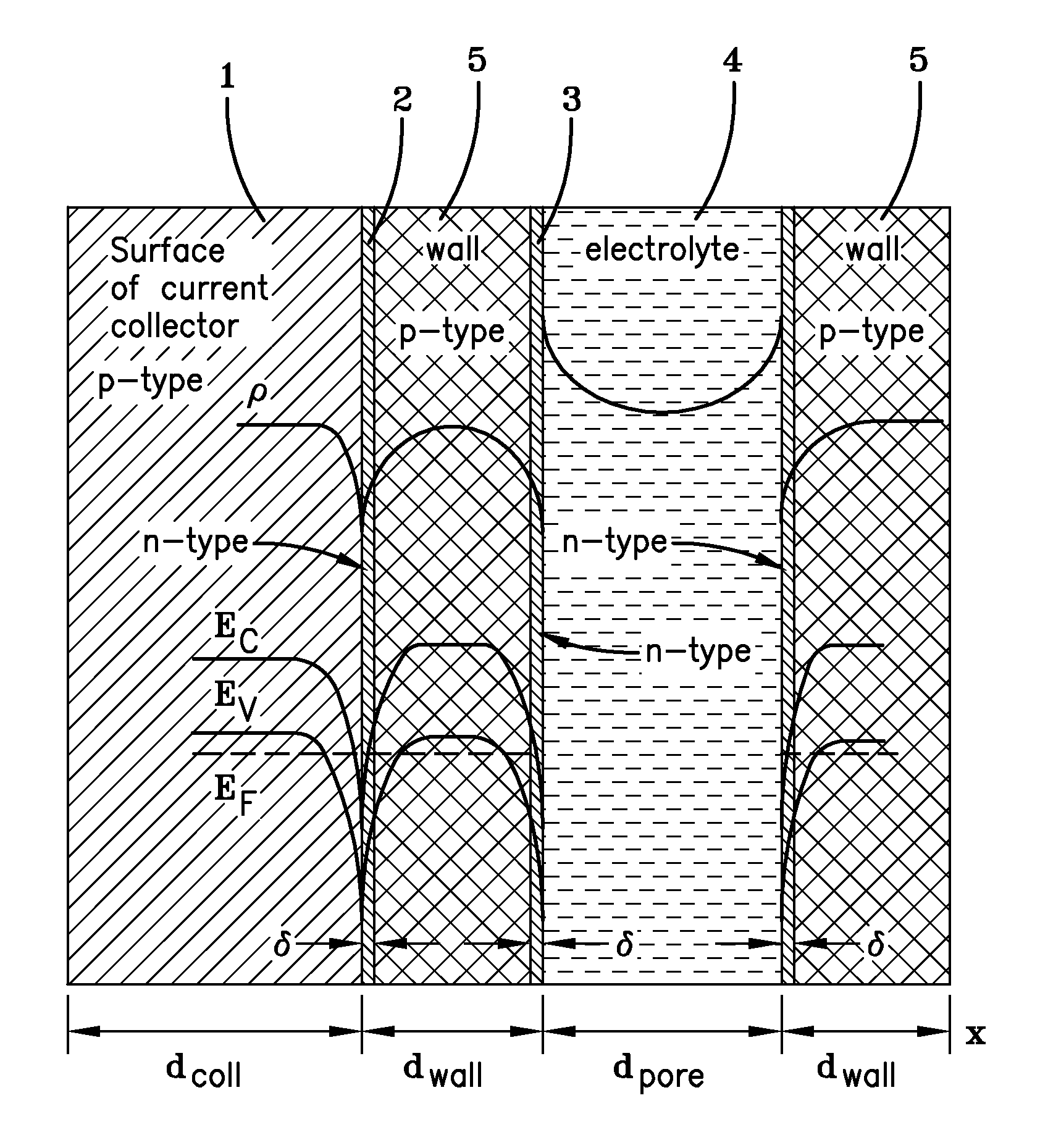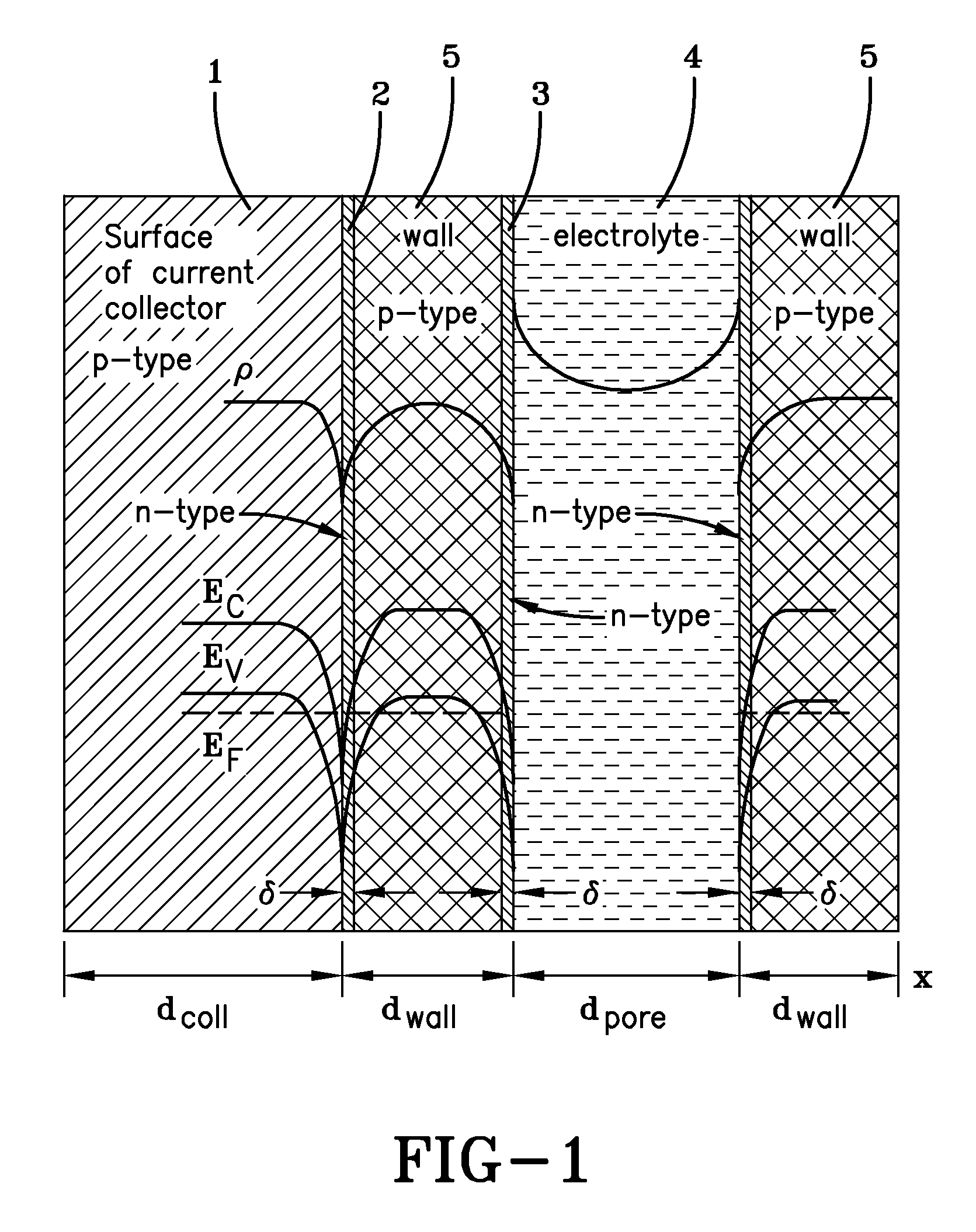Negative electrode current collector for heterogeneous electrochemical capacitor and method of manufacture thereof
a current collector and heterogeneous electrochemical technology, applied in the direction of hybrid capacitor terminals, electrolytic capacitors, liquid electrolytic capacitors, etc., can solve the problems of limited application, increased storage energy cost, and many materials that cannot provide a wide range of capacitor operating voltages, etc., to achieve high overpotential of oxygen evolution, low specific electric resistance, and good stability
- Summary
- Abstract
- Description
- Claims
- Application Information
AI Technical Summary
Benefits of technology
Problems solved by technology
Method used
Image
Examples
specific examples
Example 1
[0067]Current collector bases were cut from graphite foil having a thickness of approximately 230 μm. The overall dimensions of the current collector bases was 135 mm×72 mm×0.26 mm, as is shown in FIG. 2. The graphite foil had a specific electric resistance of 6.10−4 Ohm·cm and p-type conductivity. The mass density of the graphite foil was 1.27 g / cm3.
[0068]A protective film paste for coating the graphite foil current collector bases was manufactured using industrial carbon powder (P267E), polymer-perchlorovinyl (PVC), plasticizer (dibutyl sebacate), solvent (acetone, 11-butyl acetate and toluene), dispersant (Texaphor P61), and wetting agent (surfactant). The ratio of ingredients was 5 parts carbon powder, 15 parts PVC, 1.55 parts plasticizer, 78 parts solvent, 0.3 parts dispersant and 0.15 parts wetting agent. Following preparation and filtration, the PVC paste had a viscosity of about 775 cP (according to a Brookfield RVDV-III viscosimeter). Examination of the mass conten...
example 2
[0104]In this exemplary construction, chlorosulphated polyethylene (Hypalon®) polymer was used to protect graphite foil current collectors. In comparison to the PVC polymer used in the first capacitor HES#1, Hypalon® polymer has higher elasticity and adhesion to, among other things, carbon materials. Further, the use of this polymer in the manufacture of the protective film eliminates the need for additional components such as plasticizers and surfactants—which reduces the cost of manufacture of a current collector of the present invention.
[0105]A protective film paste was manufactured in a manner similar to that described above, and included industrial carbon powder (P267E), chlorosulphated polyethylene (Hypalon®) polymer, solvent (toluene), and dispersant (Texaphor P61). The components were present in a ratio of 2.5:8:89.45:0.05, respectively. After preparation and filtration, the Hypalon® paste had a viscosity of about 1,580 cP (according to a Brookfield RVDV-III viscosimeter). A...
example 3
[0124]Due to the fact that fluoroplastic material has an extremely high chemical stability and stable parameters in different electrolytes (including aqueous sulfuric acid electrolyte), LF-32LN varnish based on soluble fluoroplastic was used to protect graphite foil current collectors in another exemplary embodiment of the present invention. The mass composition of the LF-32LN fluoroplastic varnish was 12% fluoroplastic and 88% solvent. The viscosity of LF-32LN varnish was 68 cP (according to a Brookfield RVDV-III viscosimeter).
[0125]A protective film paste was again manufactured as earlier described. The mass composition of the paste was 3.5% industrial carbon powder (P267E), 96.35% LF-32LN varnish, and 0.15% dispersant (Texaphor P61). After preparation and filtration, the paste had a viscosity of 95 cP (according to a Brookfield RVDV-III viscosimeter). Measurements of the specific resistance and type of conductivity of an approximately 12 μm thick reference film (without a substra...
PUM
| Property | Measurement | Unit |
|---|---|---|
| thickness | aaaaa | aaaaa |
| thickness | aaaaa | aaaaa |
| particle size | aaaaa | aaaaa |
Abstract
Description
Claims
Application Information
 Login to View More
Login to View More - R&D
- Intellectual Property
- Life Sciences
- Materials
- Tech Scout
- Unparalleled Data Quality
- Higher Quality Content
- 60% Fewer Hallucinations
Browse by: Latest US Patents, China's latest patents, Technical Efficacy Thesaurus, Application Domain, Technology Topic, Popular Technical Reports.
© 2025 PatSnap. All rights reserved.Legal|Privacy policy|Modern Slavery Act Transparency Statement|Sitemap|About US| Contact US: help@patsnap.com



